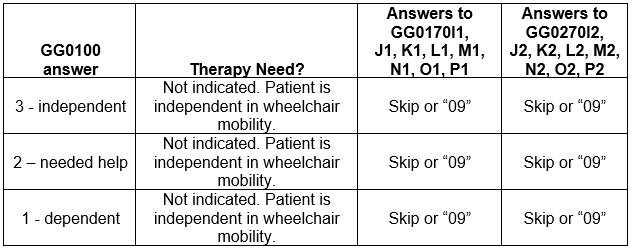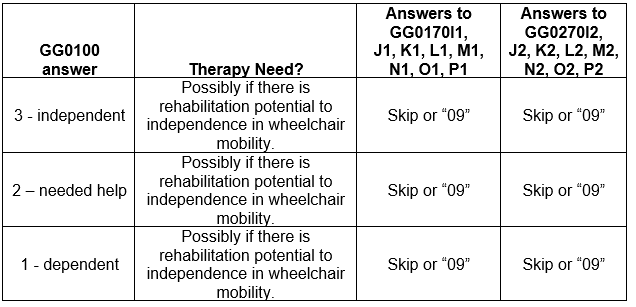Just because the patient has a mobility deficit doesn’t mean s/he is a candidate for physical therapy. The patient’s status prior to this current episode is the primary driver that determines if physical therapy is needed or not. If the patient is not a candidate for therapy and will not receive therapy, the GG0170 items can be skipped.
Physical therapy indicators are driven by GG0100B and C Prior Functioning for Indoor Mobility (Ambulation) and Stairs.
What was the patient's ambulatory status before this episode?
If the patient’s ambulatory status was better that the current status, as indicated by GG0100, s/he is a candidate  for therapy. For example: if the patient’s prior ambulatory status was independent, a “3” on GG0100B, and now requires assistance, a “2” or a “3” on M1860 Ambulation/Mobility, the patient is a therapy candidate.
for therapy. For example: if the patient’s prior ambulatory status was independent, a “3” on GG0100B, and now requires assistance, a “2” or a “3” on M1860 Ambulation/Mobility, the patient is a therapy candidate.
What if current status is the SAME as prior status?
Before 2013 and the Jimmo Settlement, Medicare expected that home health nursing and therapy would be provided only if the patient could achieve some improvement in functional performance indicators identified on OASIS.
The Jimmo Settlement in 2013 changed the coverage under Medicare program for skilled home health nursing and therapy services. Medicare enabled coverage for services when a beneficiary needs skilled care in order to maintain function or to prevent or slow decline or deterioration (and all other coverage criteria are met). If the patient’s PRIOR status is the SAME AS CURRENT status, maintenance therapy is indicated.
Let’s look at some scenarios…
If the answer to M1860 is “0” or “1”…
0 - Able to independently walk on even and uneven surfaces and negotiate stairs with or without - railings (specifically: needs no human assistance or assistive device).
1 - With the use of a one-handed device (for example, cane, single crutch, hemi-walker), able to independently walk on even and uneven surfaces and negotiate stairs with or without railings.
Answers “0” and “1” indicate the patient is independent and is not a candidate for therapy. The following answers to GG0170 I, J, K and L are recommended:
If the answer to M1860 is “2"...
2 - Requires use of a two-handed device (for example, walker or crutches) to walk alone on a level surface and/or requires human supervision or assistance to negotiate stairs or steps or uneven surfaces.
This answer indicates indicates the patient MAY be a candidate for physical therapy. The patient is independent when maneuvering flat surfaces but requires assistance with stairs and steps. But it depends on the answer to GG0100B and C...

If the answer to M1860 is “3"...
3 - Able to walk only with the supervision or assistance of another person at all times.
This answer indicates indicates the patient MAY be a candidate for physical therapy. But it depends on the answer to GG0100B and C...

If the answer to M1860 is “4"...
4 - Chairfast, unable to ambulate but is able to wheel self independently.
Since the patient now requires a wheelchair for mobility, GG0100B is answered only if the patient’s prior ability was ambulatory, not wheelchair dependent. If the patient’s prior ability was wheel-chair dependent, the answer to GG0100B should be ‘9 – not applicable’. If the patient’s prior ability was ambulatory and NOT wheelchair-dependent, consider the following:

If the answer to M1860 is “5"...
5 - Chairfast, unable to ambulate and is unable to wheel self.
As above, GG0100B is answered only if the patient’s prior ability was ambulatory, not wheelchair dependent. If the patient’s prior ability was wheelchair dependent, the answer to GG0100B should be ‘9 – not applicable’.

If the answer to M1860 is “6"...
6 - Bedfast, unable to ambulate or be up in a chair.
As above, GG0100B is answered only if the patient’s prior ability was ambulatory, not wheelchair dependent. If the patient’s prior ability was wheelchair dependent, the answer to GG0100B should be ‘9 – not applicable’.

PDGM Home Health Billing: Significant Change in Condition (SCIC)



